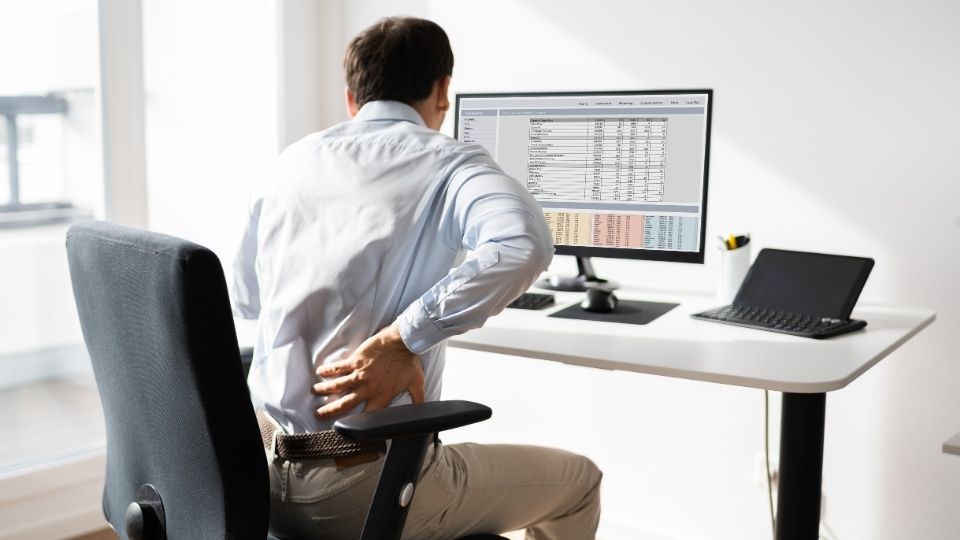Back pain is one of the most common complaints among office workers. Sitting in an uncomfortable chair for long periods of time can put a lot of strain on your back, leading to pain, stiffness, and other problems.
What can you do?
The good news is that there are a number of things you can do to reduce your risk of back pain, including adjusting your office chair to fit your body properly. All you need is a comfortable office chair.
- Adjust the height of your chair. Your feet should be flat on the floor and your thighs should be parallel to the ground. Your elbows should be bent at a 90-degree angle and your wrists should be straight.
- Adjust the backrest of your chair. The backrest should support your entire back, from your lower back to your shoulders. If your chair has lumbar support, adjust it so that it fits snugly against the curve of your lower back.
- Adjust the armrests of your chair. The armrests should support your forearms, taking some of the weight off your shoulders. Your elbows should be bent at a 90-degree angle and your wrists should be straight.
Other than Adjusting
In addition to adjusting your office chair, there are a few other things you can do to reduce your risk of back pain, including:
- Take breaks throughout the day. Get up and move around every 20-30 minutes to avoid sitting in the same position for too long.
- Stretch regularly. Stretching your back and hamstrings can help to relieve tension and improve flexibility.
- Exercise regularly. Exercise helps to strengthen your back muscles and improve your overall fitness.
If you are experiencing back pain, it is important to see a doctor to rule out any underlying medical conditions. Once you have been cleared by a doctor, you can start to implement the tips above to reduce your pain and improve your overall health.
Bonus Tips:
Here are some additional tips for optimizing your office chair for back pain relief:
- If you don’t have a lumbar support chair, use a lumbar support pillow if your chair doesn't have built-in lumbar support. A lumbar support pillow can help to fill in the gap between your back and the backrest of your chair, providing additional support for your lower back.
- Use a footrest if you have short legs or your feet don't reach the floor comfortably. A chair with a footrest can help to keep your feet flat on the floor and prevent you from slouching.
- Avoid sitting in the same position for too long. Get up and move around every 20-30 minutes to stretch your legs and back.
- Take breaks to stretch your back and hamstrings. There are a number of different stretches that you can do to relieve tension and improve flexibility in your back and hamstrings. Here are a few examples:
- Knee to chest stretch: Lie on your back with your knees bent and your feet flat on the floor. Bring one knee to your chest and hold it there with both hands. Gently pull your knee towards your chest until you feel a stretch in your lower back. Hold the stretch for 15-30 seconds and then repeat with the other leg.
- Hamstring stretch: Sit on the floor with your legs extended in front of you. Reach for your toes, keeping your back straight. If you can't reach your toes, hold onto your calves or ankles. Hold the stretch for 15-30 seconds and then repeat.
- Cat-cow stretch: Start on your hands and knees with your back flat. As you inhale, arch your back and look up. As you exhale, round your back and tuck your chin to your chest. Repeat 10-15 times.
- Exercise regularly. Exercise helps to strengthen your back muscles and improve your overall fitness. Some good exercises for your back include swimming, yoga, and Pilates.
Verdict:
By following the tips in this blog post, you can make your office chair more comfortable and reduce your risk of back pain. If you are experiencing back pain, be sure to see a doctor to rule out any underlying medical conditions.
Here are a few key takeaways from this post:
- Adjust your office chair to fit your body properly. Your feet should be flat on the floor and your thighs should be parallel to the ground. Your elbows should be bent at a 90-degree angle and your wrists should be straight.
- Take breaks throughout the day to get up and move around.
- Stretch your back and hamstrings regularly.
- Exercise regularly to strengthen your back muscles and improve your overall fitness.
If you follow these tips, you can help to prevent back pain and improve your overall health and well-being. Visit Fatio Store to find a suitable chair for your needs.





Comments